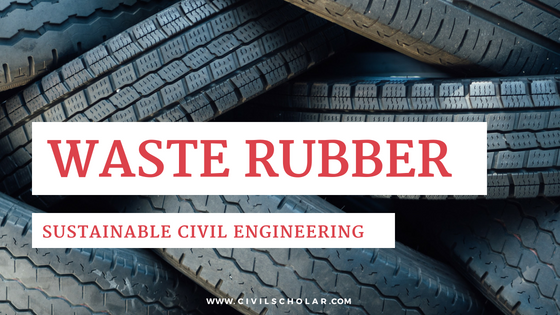Different types of wastes like plastics, glass waste, industrial byproducts etc., are being used in various applications of Civil Engineering and construction. Rubber with its unique properties of high elasticity is being used in wide range of industries like Automotive, Medical, chemical, healthcare, industrial, military, food processing etc., It is estimated that the global production of Rubber is about 26.9 million tonnes in 2016 and tend to increase annually at an average rate of 2.8% per annum till 2025 (MREPC, IRSG reports).
While, the usage of rubber is following an upward curve, the recycling and reuse of this product is showing no big difference. It is estimated that only 3-15% is getting recycled.By retreading, worn rubber tires are being reused. In marine conservation program, recycled rubber is being used as an erosion control and breakwaters, floatation devices. Apart from these recycling methods, rubber is being grinded into small matrices for using in various applications of civil engineering and military. Waste Rubber is also being used as a fuel source in steam production, cement kilns etc. Pyrolysis is also done to extract its constituents like carbon black, oil etc.
Waste Rubbers can be used as
with aggregate in different layer and on the top surface layer mixed with bitumen in percentage (5,10,15). (IJESC vol 8 issue 4)
Sources:
1 2 3 4 5
Waste Rubber and its usage
While, the usage of rubber is following an upward curve, the recycling and reuse of this product is showing no big difference. It is estimated that only 3-15% is getting recycled.By retreading, worn rubber tires are being reused. In marine conservation program, recycled rubber is being used as an erosion control and breakwaters, floatation devices. Apart from these recycling methods, rubber is being grinded into small matrices for using in various applications of civil engineering and military. Waste Rubber is also being used as a fuel source in steam production, cement kilns etc. Pyrolysis is also done to extract its constituents like carbon black, oil etc.
Waste Rubbers can be used as
- In Asphalt mixtures
- filler in roads
- in playground surfaces
- additive in portland cement concrete
- Floor mats in Automotives
- Energy source
- tools for breakwater
- to make artificial reef
- replacement for carbon black
- electrode materials
- filler in flooring, shock absorbing mat, roofing materials
In Civil Engineering
In Road Pavements
Waste Rubber from Tires can be used in the pavements along with Bitumen. The results obtained in one such research study shows that the addition of waste rubber decreases the risks of thermal cracking and permanent deformation in hot regions. It also absorbs sound thus reducing sound pollution. Waste tyre rubber is usedwith aggregate in different layer and on the top surface layer mixed with bitumen in percentage (5,10,15). (IJESC vol 8 issue 4)
As Fillers
Waste rubber were incorporated into various type of matrix such as concrete, latex, thermoplastic and thermoset materials. Addition of waste rubber as a filler altered the properties like tensile strength, modulus of elasticity, flexibility etc.Geotechnical Applications
Waste rubber fibres mixed with cement and clay can be use as fill material, backfill material for retaining wall, sub-base of low volume traffic roads, and side slope of the canal. In one study, it is reported that the incorporation of rubber fibre reduces the unconfined compressive strength and split tensile strength of cement-stabilized clay but prosperously improves the rate of loss of post-peak strength and change the brittle failure behavior of cemented clay to ductile.Crumb Rubber Concrete
Replacing a part of aggregates in concrete with crumb rubber(Scrap tires grinded into small particles) produces a product called Crumb Rubber Concrete (CRC). Compared to conventional concrete, CRC possess higher ductility and damping ratio. It favors the structure when it subjected to seismic loads. Research work is ongoing to use CRC in seismic structures.Sources:
1 2 3 4 5
